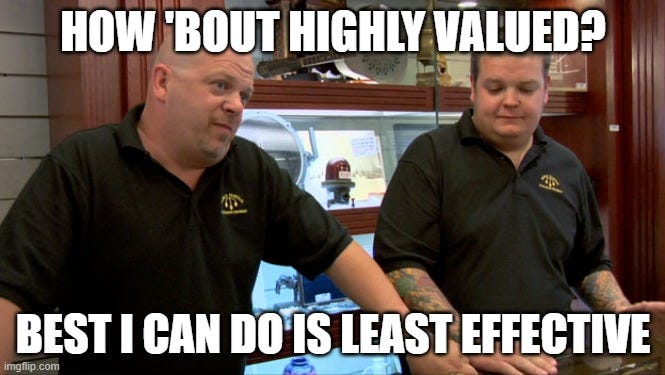Seven Key Notes on Amazon's Talent Process
Report paints a grim picture both better and worse than reality
A friend put this Business Insider article on my radar.
It paints a grim picture of an Amazon corporate employee pushed out of his job through the company’s “Pivot” performance management process.
Pivot gives under-performing salaried staff a choice: take a lump sum payout and walk, or agree to a structured improvement plan at the risk of being fired empty-handed if you fail to progress.
When properly done, it’s not a bad process at all. But the overall talent management process within which it is situated does have some problems, which can impact how Pivot is lived by individual employees.
Having performance managed many scores of employees at Amazon and elsewhere, let me explain what I mean, which involves telling you some things you wouldn’t know from reading an underwhelming yet important Business Insider account.
Performance Management Should Never Be a Surprise.
The article portrays an employee ambushed by performance management after basically being great before. Almost certainly this omits material details of how he ended up in Pivot. Before anyone ends up there, they’ve been given considerable feedback that they’re below the bar and coached for weeks or months to recover.
This assumes managers and HR properly following the process. There may be toxic pockets of Amazon where this doesn’t happen, but it’s not something I saw in my time there.
Many People Recover.
The article portrays Pivot as a death sentence. This is not so. Conducted in earnest, it can and often does result in someone recovering to a much stronger position. You can find many senior managers at Amazon who were performance managed at some stage.
This is important. Scaled bureaucracies like the one Amazon is slowly morphing into naturally gravitate to zero-defect mentalities. This can result in the advancement of pragmatists who never risk anything at the expense of grafters who are bold and searching and learn through challenge. Let’s hope that doesn’t happen.
It Takes Resources to Get it Right.
HR partners provide essential support to managers in performance management scenarios. They make sure objectives are clear and achievable. They make sure meetings happen and get documented. They keep managers objective. Their process guidance underwrites fairness. So when Amazon chops HR staffs, it raises the risk of getting things like Pivot wrong.
How People End Up in Pivot Is Problematic.
Some end up being managed because in the course of normal business, the line manager observes performance consistently below the bar. Support and an improvement plan are not successful, so the individual progresses to formal performance management. These are usually clear-cut cases that someone is in the wrong role and perhaps the wrong business.
The other way people end up managed is by getting designated as low performers in a talent review. This process brings senior managers together to discuss an entire talent pool and give each individual a rating which drives their compensation and next steps in the business. A percentage of individuals will be identified as needing improvement and will be entered into improvement plans.
But here’s the catch. Even if everyone has done well in the past year, some will be pushed into the lowest category and managed. Amazon (joined by many other big employers) believes in forcing a performance curve upon its talent pool and identifying low performers no matter what.
If everyone performed well objectively, the goalpost turns on its axis and measures comparative performance in order to isolate the requisite percentage to hit the curve.
I’ve seen examples of reviews that struggled mightily to designate low performers because there weren’t any, particular at senior management levels in high-performing teams. But in the end, someone will be picked.
This creates absurdity. A line manager who doesn’t believe in what they are doing puts someone in a professional penalty box, injuring trust and undermining the relationship they’ve worked to build. In some cases, the blow to their confidence causes these individuals to lose their footing under scrutiny, their degraded performance creating a self-fulfilling prophecy that falsely makes the talent review look correct.
Lots of energy gets wasted playing make believe, and in some cases it results in valuable performers being pushed out of their roles and sometimes out of the company. Amazon will comfort itself that these people weren’t good enough, and sometimes it will be right. Sometimes, it will be wrong, and those false negatives are toxic to its value system and culture.
This dynamic would have been more fertile ground for Business Insider to explore, because it houses other absurdities that many passionate Amazon leaders have moaned about for years, generally met with a hand wave or simply ignored.
There Is Improper Influence.
Imagine being directed to manage someone even though you, the actual manager, don’t believe they’re under-performing. Then having to report weekly to the person who twisted your arm and who also holds your career and livelihood in their hands.
This is exactly what happens.
Line managers are not entrusted with managing their struggling performers. The norm is for recurring meetings with a more senior leader who is not dispassionate about the situation and has something to gain from being seen as tough on under-performance.
This becomes a test of integrity for supervisors committed to making objective and fair talent decisions, and is compounded when they themselves are under caution or otherwise trying hard to impress their boss.
It’s a stew of distortion and manipulation, some of it unintentional, with human beings and their livelihoods at stake.
Performance Management is a Risk Control Measure.
There’s an old saying in HR circles that you can fire anyone you want, so long as you’re willing to take the risk. Performance management processes are not merely earnest methods to recover struggling delivery. They are methods to document performance and show there was an effort to help before bouncing someone out of a job. This reduces the risk of successful lawsuits for wrongful termination.
Performance Management Lacks a Strong Link With Hiring.
If someone has low tenure, was recently promoted, or is in a new role … and already they’re being managed, it is fair to ask whether we got that earlier decision right.
If they were a good hire, then their performance says as much about the environment they’re in and the manager supervising them as it does about them individually.
If they were a bad hire, we should care about that. If it becomes a trend that someone is pushing the wrong people for promotion or hiring people who serially fail, we should double-click on that hiring manager and take an interest in their performance. Even and especially if they are a VP with masses of power to hire and push.
My experience at Amazon was that when someone performed poorly, we tended to resist getting upstream and asking the hard questions about who pushed them and whether their talent compass needed re-calibrating.
This was unusual within a culture of restlessly seeking out and addressing root causes. But perfectly normal within a culture overly deferential to senior leaders, including their autocratic whimsies about talent management and progression.
The points I make here and the tone I employ might give the impression I am net negative on Amazon’s talent processes. This isn’t really the case.
I don’t pretend that a company operating at a such a massive scale can be organized, efficient, tailored, and perfect all at once. There will be instances where a process that normally works well is a bad fit for the circumstances. Or humans will just make mistakes.
What I would say is that Amazon is at risk of slipping out of its cherished “Day One” culture, marked by commitment to its founding principles, and into a lumbering, bureaucratic culture which will kill every molecule of joy before slaying the very innovation the company needs to stay amazing.
Talent management processes should be considered fair game for questions and revisions, like anything else. When I see this PR response to the Business Insider piece, it sounds like the company is not open to the idea of anything being wrong:
Like most companies, we have a performance management process that helps our managers identify who on their teams are performing well and who may need more support. For the small number of employees who are under-performing, we use performance management programs to help them improve, and many employees do just that. Sometimes the programs result in employees leaving the company. Business Insider declined to share the information needed to verify this individual's account, but from the questions we were asked, it's likely this essay will contain inaccuracies about our performance management process.
That’s less reassuring than defensive. Where’s the confirmation that Amazon is listening, doesn’t intend what was chronicled in the article, and is open to feedback? Why not just explain how the Pivot process works? It’s a great opportunity to tout a world-class element of a world-best talent approach.
Unless, of course, the company doesn’t believe in its own approach.
My message for my former employer is that accepting any mediocrity in talent processes will lead to outsized mediocrity in execution.
Turning over a percentage of your team arbitrarily, at considerable expense, while pretending you’re driving decisions with facts and evidence, falls short of the values which make the company.
Forcing a talent curve is like bone grafting a Day Two fibula from the decrepit body of modernist bureaucracy and then expecting to sprint.
And resisting feedback about it?
Well … ask Enron how that worked out.
TC held senior management roles at Amazon for many years. He is an independent writer, speaker, and consultant on organizational leadership, and a veteran of the United States military.









